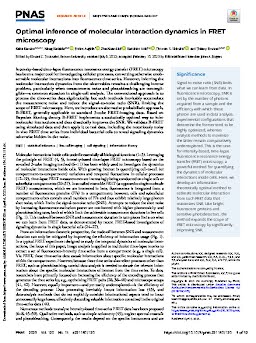2023-04-04
Optimal inference of molecular interaction dynamics in FRET microscopy
Publication
Publication
PNAS , Volume 120 - Issue 15 p. e2211807120: 1- 12
Intensity-based time-lapse fluorescence resonance energy transfer (FRET) microscopy has been a major tool for investigating cellular processes, converting otherwise unob-servable molecular interactions into fluorescence time series. However, inferring the molecular interaction dynamics from the observables remains a challenging inverse problem, particularly when measurement noise and photobleaching are nonnegli-gible-a common situation in single-cell analysis. The conventional approach is to process the time-series data algebraically, but such methods inevitably accumulate the measurement noise and reduce the signal-to-noise ratio (SNR), limiting the scope of FRET microscopy. Here, we introduce an alternative probabilistic approach, B-FRET, generally applicable to standard 3-cube FRET-imaging data. Based on Bayesian filtering theory, B-FRET implements a statistically optimal way to infer molecular interactions and thus drastically improves the SNR. We validate B-FRET using simulated data and then apply it to real data, including the notoriously noisy in vivo FRET time series from individual bacterial cells to reveal signaling dynamics otherwise hidden in the noise.
| Additional Metadata | |
|---|---|
| PNAS | |
| The Netherlands Organisation for Scientific Research (NWO) | |
| doi.org/10.1073/pnas.2211807120 | |
| PNAS | |
| Organisation | Physics of Behavior |
|
Kamino, K., Kadakia, N., Avgidis, F., Liu, Z.-X., Aoki, K., Shimizu, T., & Emonet, T. (2023). Optimal inference of molecular interaction dynamics in FRET microscopy. PNAS, 120(15), e2211807120: 1–12. doi:10.1073/pnas.2211807120 |
|
